We are at a loss for words about Easter Island. From the onset, the island caressed us with its tropical flower scents, trade wind breezes, the warmth of the locals and the unfettered freedom we enjoyed. All the while under the ever present mysterious gaze of the stone Moai. It was as if we were embraced and altered forever.
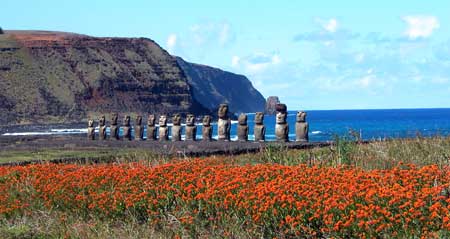 We had been traveling in Chile on business and couldn’t resist the pull to visit Easter Island. Easter Island, a protectorate of Chile retains its own sovereign culture. The Chileans call it Isla Pascua or Easter Island in Spanish. The natives know it as Rapa Nui.
We had been traveling in Chile on business and couldn’t resist the pull to visit Easter Island. Easter Island, a protectorate of Chile retains its own sovereign culture. The Chileans call it Isla Pascua or Easter Island in Spanish. The natives know it as Rapa Nui.
I made some phone calls and used our Frequent Flyer points to schedule a flight. It seemed expensive and later I realized it deserved to be expensive. The island is the most geographically remote place on the planet. There was only one daily flight. We boarded a huge plane that was completely full. Hundreds of passengers lined up with sandals, Hawaiian shirts and backpacks. The flight was to be six hours long.
We were just being spontaneous, which is one of our little thrills in life. A six hour flight was definitely a surprise; further then a flight from California to Hawaii. Most passengers were continuing on to Tahiti with only a few disembarking with us.
As we approached Isla Pascua, the plane banked hard and flew close to the green craggy bluffs below. This was a little island, seemingly adrift in the vast Southern Pacific. We could see the runway was just a short strip on the narrowest waistline of the island. It started and stopped on cliff edges. Could this behemoth of a jet actually stop that quickly?
We descended and I swear there was a collective sigh from the passengers when we finally stopped. As we disembarked out on the tarmac we were welcomed immediately with sweet-smelling flower leis. We’d been told that we needed to buy our National Park Pass with pesos before entering the terminal at the little kiosk. No one was there so went on to the small terminal and waiting for our luggage. Families were reuniting and locals held up handmade cardboard signs advertising their accommodations.
We were finally here. Rapa Nui. An end-of-the earth destination reserved for Archeologist and National Geographic researchers. Neither of us ever imagined we would get to visit this isolated myth-shrouded island.
We were warmly greeted by Edith, our hostess from little Taur’ra Hotel. Another couple, both scientists from the Seattle area piled in to Edith’s tiny van with us, and we began a brief tour around Hanga Roa. It didn’t take more than 10 minutes for us to see all the streets in town. Parking on the residential street next to the Hotel, Edith asked us to follow her to the office. She mixed up fresh mango juice cocktails. The four of us, wide eyed eager visitors, settled into heavy rattan chairs sipping on the sweet mixture. In her rustic pigeon English, Edith laid out the agenda she had for us all, with arrangements for various minibus and cultural tours for our entire visit. Without being rude, we thanked her for her thoughtfulness and declined. Saying that we planned to try and go horseback riding. We wanted to experience Easter Island on our own terms. If we didn’t learn as much we would make up for it with our own sense of discovery.
It is common in Easter Island to get channeled by your hosts into a set of tours. Everyone is related and the Tour Guides, Car rental agencies and Traditional Dance Companies are all relatives of your host. Often your host is working in multiple capacities. The incestuous culture is to be expected on such a remote and small island and we wanted to be sensitive to their need to cultivate income without offending anyone.
Settling into our simple and homey room we were touched to see champagne and fresh picked tropical garden flowers. We were starting to unpack when there was a knock at the door. John opened the door to find Edith. In her quaint broken English she proclaimed “The horse man here, you go ride now”. Although we would have preferred a little more notice, we grabbed our boots and slid into our jeans. Out on the street we met Pantu and his ranch hand Kiko. We all piled into the front seat of their pickup truck and headed somewhere. Few people speak English. Pantu spoke some English and Spanish. Most people speak Rapanui, a Polynesian language native to the island.
The truck ride in itself was fun as we kick-offed our introduction to the island up close. Cows and horses ranged freely in the green fields that rolled down to the serene and endless Pacific. We ask Pantu who the livestock belonged to, and he replied “to Rapa Nui”. It seems that feral livestock are part of the culture of this agrarian society. In fact it became a common thing to hear from the locals that there were more horses then people.
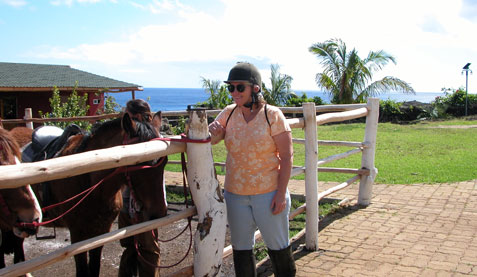 Pantu pulled into his vivid green ocean bluff property. He had a well-kept comfortable home with a million dollar view. The horses were stabled in the family yard. We followed Pantu into his barn to select leather shin guards and helmets before being introduced to our mounts. They endeared themselves immediately, seeming happy for the company and the opportunity to get away from the coral.
Pantu pulled into his vivid green ocean bluff property. He had a well-kept comfortable home with a million dollar view. The horses were stabled in the family yard. We followed Pantu into his barn to select leather shin guards and helmets before being introduced to our mounts. They endeared themselves immediately, seeming happy for the company and the opportunity to get away from the coral.
A few minutes later we and Kiko, headed out the gate and into the open countryside of Easter Island. It was apparent right away that this was not going to be a classic trail ride where we were doomed to shuffle behind the horse in front of us. Kiko and his horses loved to run. Boundless blue Pacific horizons frame the endless green fields and stone walls that we explored. The horses trotted with no encouragement.
Soon we are cantered across pastures, down muddy hillsides, through farmers’ fields and over creeks. When we came upon a National Park sign marking the site of lava tube caves in the ground, we all dismounted and tied up our horses. Kiko handed us each a flashlight and suggesting we keep our helmets on too. We were going down into the caves. John went first, crawling through a small opening in the ground. 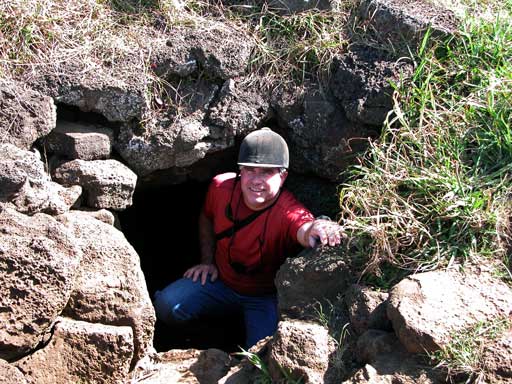 Once down underground we followed Kiko’s torch light across the rough surfaces of the inside of the lava tube.
Once down underground we followed Kiko’s torch light across the rough surfaces of the inside of the lava tube.
Rounding a turn in the lava tube we were temporarily blinded by a blast of white light. The entire cave emptied into a large room that opened onto a cliff face with crashing surf below. 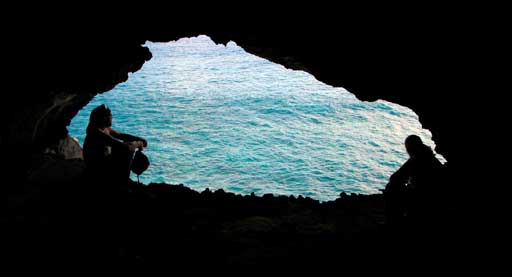 We sat near the cliff window, mesmerized by the large rolling surf straight below us.
We sat near the cliff window, mesmerized by the large rolling surf straight below us.
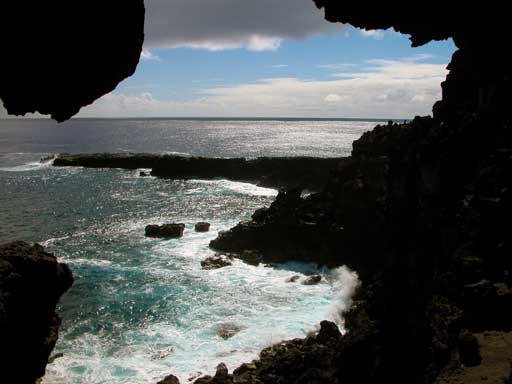 There seemed to be absolutely no rush. Time was of no consequence. We were enveloped in an ancient space. All sound seemed to be eliminated except for the sound of the surf below. Kiko seemed as content as we were. Eventually we all moved towards the entrance and reemerged out the entrance like Alice emerging from Wonderland.
There seemed to be absolutely no rush. Time was of no consequence. We were enveloped in an ancient space. All sound seemed to be eliminated except for the sound of the surf below. Kiko seemed as content as we were. Eventually we all moved towards the entrance and reemerged out the entrance like Alice emerging from Wonderland.
The islands volcanic origins make for coarse terrain with rocks and boulders. Dirt roads gently stretch off in interior directions with stone walls occasionally shaping the landscape. There are strong similarities to rural Ireland here that we didn’t expect. We next visited some open Lava caverns previously inhabited by the islanders though the millennium as subterranean homes and gardens. We wander around garden patches still yielding crops that sprouted from ancient seeds.
There was more to see, although we had no idea where Kiko was taking us. He only spoke Rapanui. We eagerly remounted and headed off. Occasionally Kiko would stop to tear a twig off a tree, ride it back to me and with enthusiastic sign language encouraging me to use it as a riding crop. He was happiest when we are all galloping at full speed. It was a RUSH.
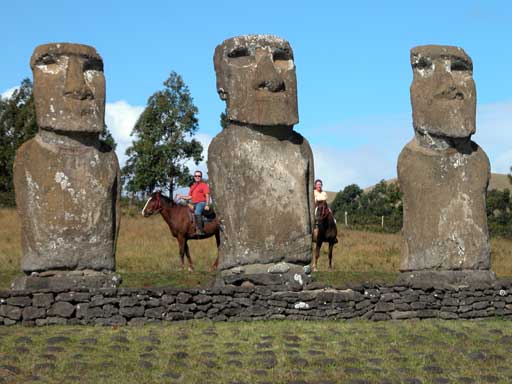 We wandered seemingly without concern through private yards and properties and finally up a dirt road, void of any vehicles. At the top of the hill we passed through a gate onto National Park property and rode up to our first row of Moai. They were massive, regal and enduring. Each Moai exuded their own personality with slight individualistic nuances in their carved design.
We wandered seemingly without concern through private yards and properties and finally up a dirt road, void of any vehicles. At the top of the hill we passed through a gate onto National Park property and rode up to our first row of Moai. They were massive, regal and enduring. Each Moai exuded their own personality with slight individualistic nuances in their carved design.
The sun was descending and the Moai shadows grew long. Their company and the distant vistas of the southern coastline were hard to leave as we turned our horses back towards Pantu’s ranch. Hours later we meander back to the corral, just as the sun squatted on the uninterrupted horizon line.
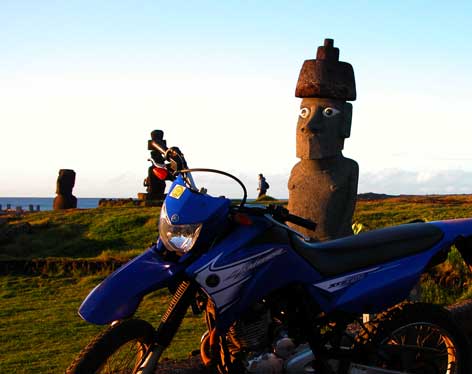 The next day, we rented a motorcycle and headed out along the coast road and up to the Rano Kao volcano Crater Lake. It is a beautiful swampy hole of green liquid, with the deep blue sea as a backdrop beyond. We read the signs about the history of Rano Kao and then climbed back on to ride the dusty road further up the mountain to Orongo.
The next day, we rented a motorcycle and headed out along the coast road and up to the Rano Kao volcano Crater Lake. It is a beautiful swampy hole of green liquid, with the deep blue sea as a backdrop beyond. We read the signs about the history of Rano Kao and then climbed back on to ride the dusty road further up the mountain to Orongo.
There we found stone ceremonial houses in a village grouping and a small museum. We paid a small admission fee to learn about the Bird Man competition. The ancient competition continues still with modern islanders. Like their ancestors, Rapa Nui men climb down the ragged cliff, dive into the ocean with a reed raft they carry on their backs, swim out to the small islet of Moto Nui and climb up the rocky island pinnacle to the nesting area of the Sooty terns. Competitors able to survive the treacherous climbs, swift currents and sharks return hopefully with their scavenged tern eggs still intact. Only then have they earned the right to go through a spiritual preparation ceremony.
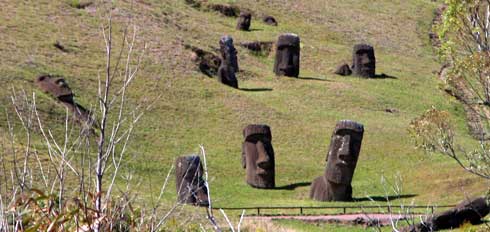 We continued on to the ancient Moai quarry where much of the research and theories about the history of these unique stone creatures has been concentrated. Dozens of Moai’s lie scattered and abandoned on the steep hillside. After a long day exploring we headed back into Hanga Roa for a beer at a seaside restaurant to watch surfers tame the southern ocean waves. We walked through town and joined other visitors at the main park to watch for the green flash at sunset. As a concession to our hostess Edith, we bought two tickets to the Kari Kari cultural dance show and dinner where we ran into our hotel mates from Seattle. The four of us enjoyed a night cap at a small establishment along the walk back to our hotel. The stars easily lit our path in the absence of street lights.
We continued on to the ancient Moai quarry where much of the research and theories about the history of these unique stone creatures has been concentrated. Dozens of Moai’s lie scattered and abandoned on the steep hillside. After a long day exploring we headed back into Hanga Roa for a beer at a seaside restaurant to watch surfers tame the southern ocean waves. We walked through town and joined other visitors at the main park to watch for the green flash at sunset. As a concession to our hostess Edith, we bought two tickets to the Kari Kari cultural dance show and dinner where we ran into our hotel mates from Seattle. The four of us enjoyed a night cap at a small establishment along the walk back to our hotel. The stars easily lit our path in the absence of street lights.
Our final day on the island came too soon, and we didn’t want to miss a moment of it. We set our alarm and got up in the dark, bundled up and climbed on to our motorcycle. John steered us towards the wild Northern coast to see the sun rise over the ancient harbor and random scattered Moai’s. In the predawn light we picked our way amongst miles of tilting and individualize Moai’s. Their faces staring down at us. The stalwart Moai gazed on us with a sort of timelessness for them and us.
The sun bore a welcome hole in the cold wind that had pushed unceasingly on us in those early morning hours. We headed on towards the distant Eastern coast, stopping and wandered through some of thousands of archeological sites on the island. We were truly experiencing Rapa Nui on our own terms. Occasionally we would pass someone and wave or have to stop and wait for a cluster of horses or cows to cross in front of us. But mostly the island seemed intimately ours to discover.
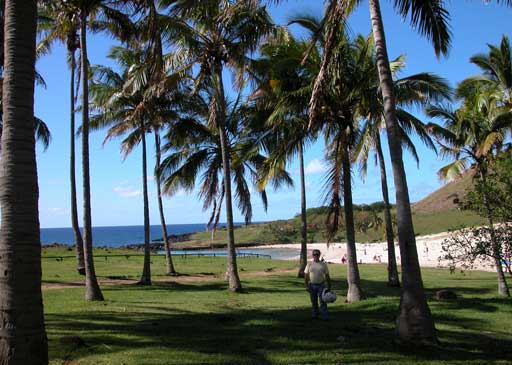 Without knowing, we accidentally had saved the best for last. The road took a hard turn at Anakena Beach as it looped back toward Hanga Roa. We stopped in the beach parking lot.
Without knowing, we accidentally had saved the best for last. The road took a hard turn at Anakena Beach as it looped back toward Hanga Roa. We stopped in the beach parking lot.
At the top of a deep elliptical sandy valley stood a council of mighty Moai, known as the Ahu Ature Huki. Their presence was authoritarian. The sandy landscape swept steeply down towards a tight crescent beach hosting perfect ankle high waves. On the left side of the cove, horses and cattle freely grazed, sometimes wandering down to the beach to mix with the bathers in the shallow warm waters. The sand was absolutely white.
The cove at Anakena recessed deeply into the island, providing shelter from the otherwise constant break of the Southern Pacific. Legend has it that one of the cliff side caves was once home to the original King, the father of all Rapa Nui. We spent a couple of hours wading in the water, lunching on snacks we bought at the small concession and napping on the lawn under the shade of a coconut palm forest that framed the beach. Never has a spa achieved the same level of peace that we experienced here. Anakena Beach was nature showing off.
Our time on Rapa Nui is imprinted on our memories like the chisel marks on the Moai statues. Many people come to Rapa Nui to understand the mysteries of the ancients. We came to recognize there is an unexplainable magic on this island that has etched itself into us forever.
In your life, if you can, visit Rapa Nui.
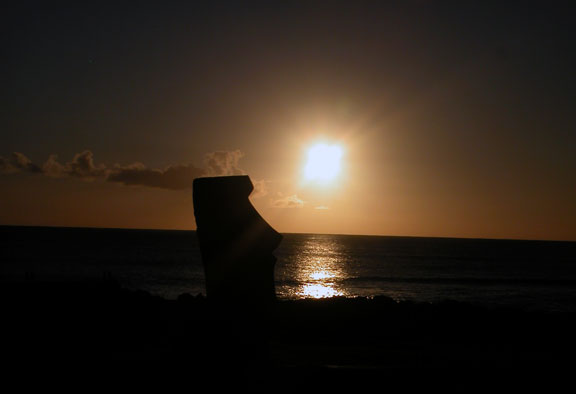
TIPS:
- Bring your Pesos with you. Banking and getting cash can be almost impossible. The ship with cash only comes in once a month, so the ATM’s remain empty.
- Buy your National Park pass when you get off the plane at the little kiosk. It’s cheaper than at the quarry or other National Park sites.
- If you don’t speak Spanish, bring a translation guide or tool. Few people speak any English.
- You are asked to pack all your trash off the island that includes plastic water bottles etc.
- Travel lite. Hiking sandals, shorts, a lite cover up for the cooler evenings and a bathing suit are advised.
Leave a Reply